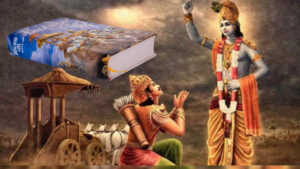Chapter 2 of the Bhagavad Gita is called “Sankhya Yoga” or “The Yoga of Knowledge and Renunciation.” In this chapter, Lord Krishna continues to counsel Arjuna on the importance of performing one’s duty without attachment to the fruits of action. He also delves deeper into the nature of the self and the world, and explains the concept of Sankhya, which is one of the six classical Indian philosophical systems.
The chapter begins with Lord Krishna telling Arjuna that it is through knowledge of the self and the nature of the world that one can attain liberation. He then goes on to describe the three modes of material nature: goodness, passion, and ignorance, and how they influence the mind and intelligence of living beings.
Lord Krishna then explains the concept of Sankhya, which is the knowledge of the distinction between the eternal soul and the temporary material body. He states that those who understand this distinction and are able to detach themselves from the material world can attain liberation.
Sankhya’s philosophy asserts that there are two realities: the eternal, unchanging, and conscious soul, known as Purusha, and the constantly changing and unconscious material world, known as Prakriti. The goal of Sankhya is to understand the distinction between these two realities and to detach oneself from the material world in order to attain liberation.
Lord Krishna states that the eternal soul is the observer and the experiencer of the material world, but it is not affected by the material world. He emphasizes that the material body and the material world are temporary and subject to change, while the eternal soul is permanent and unchanging. He also states that the eternal soul is not born and does not die, it is eternal and indestructible.
Lord Krishna also explains that the material world is the result of the interaction between the three modes of material nature: goodness, passion, and ignorance, which influence the mind and intelligence of living beings.
Sankhya also emphasizes the importance of knowledge and discrimination as the means to attain liberation. It teaches that one must develop the ability to discriminate between the permanent and the transient, the real and the unreal, and the self and the non-self.
He also describes the qualities and characteristics of a person who has attained this knowledge, such as being peaceful, self-controlled, and free from attachment and aversion.
He then explains the path of Karma yoga as the path to attain this knowledge. He states that one should perform their duty without attachment to the fruits of action, and with a sense of detachment and devotion to God. He also explains that this path is not just for ascetics, but for all people, regardless of their social status or occupation.
In the last slokas of this chapter, Lord Krishna describes the ultimate goal of human life: to attain the supreme state of spiritual consciousness, and the ultimate state of liberation, known as moksha. He emphasizes that by following the path of Karma yoga, one can attain this ultimate goal.
It’s important to note that Bhagavad Gita’s slokas are full of profound wisdom and are open to multiple interpretations, reading commentaries or studying with a qualified teacher may help in understanding the deeper meaning of each sloka.

